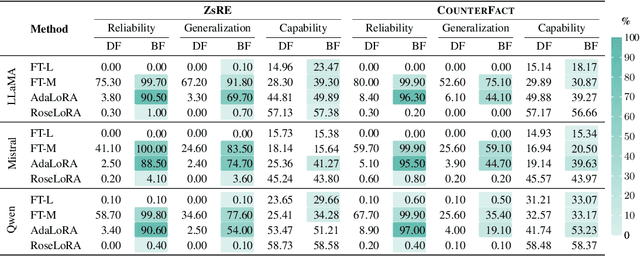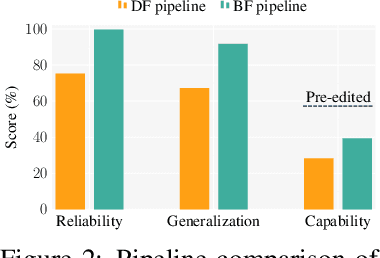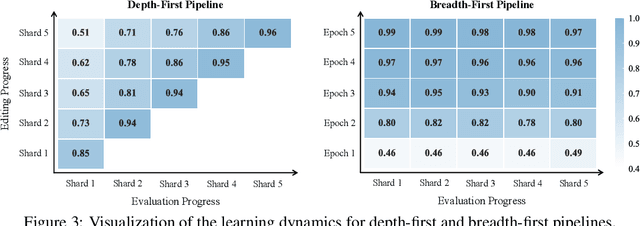Rui Tang
KooLab, Kujiale.com, Hangzhou China
Fine-tuning Done Right in Model Editing
Sep 26, 2025



Abstract:Fine-tuning, a foundational method for adapting large language models, has long been considered ineffective for model editing. Here, we challenge this belief, arguing that the reported failure arises not from the inherent limitation of fine-tuning itself, but from adapting it to the sequential nature of the editing task, a single-pass depth-first pipeline that optimizes each sample to convergence before moving on. While intuitive, this depth-first pipeline coupled with sample-wise updating over-optimizes each edit and induces interference across edits. Our controlled experiments reveal that simply restoring fine-tuning to the standard breadth-first (i.e., epoch-based) pipeline with mini-batch optimization substantially improves its effectiveness for model editing. Moreover, fine-tuning in editing also suffers from suboptimal tuning parameter locations inherited from prior methods. Through systematic analysis of tuning locations, we derive LocFT-BF, a simple and effective localized editing method built on the restored fine-tuning framework. Extensive experiments across diverse LLMs and datasets demonstrate that LocFT-BF outperforms state-of-the-art methods by large margins. Notably, to our knowledge, it is the first to sustain 100K edits and 72B-parameter models,10 x beyond prior practice, without sacrificing general capabilities. By clarifying a long-standing misconception and introducing a principled localized tuning strategy, we advance fine-tuning from an underestimated baseline to a leading method for model editing, establishing a solid foundation for future research.
SPATIALGEN: Layout-guided 3D Indoor Scene Generation
Sep 18, 2025Abstract:Creating high-fidelity 3D models of indoor environments is essential for applications in design, virtual reality, and robotics. However, manual 3D modeling remains time-consuming and labor-intensive. While recent advances in generative AI have enabled automated scene synthesis, existing methods often face challenges in balancing visual quality, diversity, semantic consistency, and user control. A major bottleneck is the lack of a large-scale, high-quality dataset tailored to this task. To address this gap, we introduce a comprehensive synthetic dataset, featuring 12,328 structured annotated scenes with 57,440 rooms, and 4.7M photorealistic 2D renderings. Leveraging this dataset, we present SpatialGen, a novel multi-view multi-modal diffusion model that generates realistic and semantically consistent 3D indoor scenes. Given a 3D layout and a reference image (derived from a text prompt), our model synthesizes appearance (color image), geometry (scene coordinate map), and semantic (semantic segmentation map) from arbitrary viewpoints, while preserving spatial consistency across modalities. SpatialGen consistently generates superior results to previous methods in our experiments. We are open-sourcing our data and models to empower the community and advance the field of indoor scene understanding and generation.
In vivo 3D ultrasound computed tomography of musculoskeletal tissues with generative neural physics
Aug 17, 2025Abstract:Ultrasound computed tomography (USCT) is a radiation-free, high-resolution modality but remains limited for musculoskeletal imaging due to conventional ray-based reconstructions that neglect strong scattering. We propose a generative neural physics framework that couples generative networks with physics-informed neural simulation for fast, high-fidelity 3D USCT. By learning a compact surrogate of ultrasonic wave propagation from only dozens of cross-modality images, our method merges the accuracy of wave modeling with the efficiency and stability of deep learning. This enables accurate quantitative imaging of in vivo musculoskeletal tissues, producing spatial maps of acoustic properties beyond reflection-mode images. On synthetic and in vivo data (breast, arm, leg), we reconstruct 3D maps of tissue parameters in under ten minutes, with sensitivity to biomechanical properties in muscle and bone and resolution comparable to MRI. By overcoming computational bottlenecks in strongly scattering regimes, this approach advances USCT toward routine clinical assessment of musculoskeletal disease.
Knowledge-aware Diffusion-Enhanced Multimedia Recommendation
Jul 22, 2025



Abstract:Multimedia recommendations aim to use rich multimedia content to enhance historical user-item interaction information, which can not only indicate the content relatedness among items but also reveal finer-grained preferences of users. In this paper, we propose a Knowledge-aware Diffusion-Enhanced architecture using contrastive learning paradigms (KDiffE) for multimedia recommendations. Specifically, we first utilize original user-item graphs to build an attention-aware matrix into graph neural networks, which can learn the importance between users and items for main view construction. The attention-aware matrix is constructed by adopting a random walk with a restart strategy, which can preserve the importance between users and items to generate aggregation of attention-aware node features. Then, we propose a guided diffusion model to generate strongly task-relevant knowledge graphs with less noise for constructing a knowledge-aware contrastive view, which utilizes user embeddings with an edge connected to an item to guide the generation of strongly task-relevant knowledge graphs for enhancing the item's semantic information. We perform comprehensive experiments on three multimedia datasets that reveal the effectiveness of our KDiffE and its components on various state-of-the-art methods. Our source codes are available https://github.com/1453216158/KDiffE.
SpatialLM: Training Large Language Models for Structured Indoor Modeling
Jun 09, 2025Abstract:SpatialLM is a large language model designed to process 3D point cloud data and generate structured 3D scene understanding outputs. These outputs include architectural elements like walls, doors, windows, and oriented object boxes with their semantic categories. Unlike previous methods which exploit task-specific network designs, our model adheres to the standard multimodal LLM architecture and is fine-tuned directly from open-source LLMs. To train SpatialLM, we collect a large-scale, high-quality synthetic dataset consisting of the point clouds of 12,328 indoor scenes (54,778 rooms) with ground-truth 3D annotations, and conduct a careful study on various modeling and training decisions. On public benchmarks, our model gives state-of-the-art performance in layout estimation and competitive results in 3D object detection. With that, we show a feasible path for enhancing the spatial understanding capabilities of modern LLMs for applications in augmented reality, embodied robotics, and more.
EndoARSS: Adapting Spatially-Aware Foundation Model for Efficient Activity Recognition and Semantic Segmentation in Endoscopic Surgery
Jun 07, 2025Abstract:Endoscopic surgery is the gold standard for robotic-assisted minimally invasive surgery, offering significant advantages in early disease detection and precise interventions. However, the complexity of surgical scenes, characterized by high variability in different surgical activity scenarios and confused image features between targets and the background, presents challenges for surgical environment understanding. Traditional deep learning models often struggle with cross-activity interference, leading to suboptimal performance in each downstream task. To address this limitation, we explore multi-task learning, which utilizes the interrelated features between tasks to enhance overall task performance. In this paper, we propose EndoARSS, a novel multi-task learning framework specifically designed for endoscopy surgery activity recognition and semantic segmentation. Built upon the DINOv2 foundation model, our approach integrates Low-Rank Adaptation to facilitate efficient fine-tuning while incorporating Task Efficient Shared Low-Rank Adapters to mitigate gradient conflicts across diverse tasks. Additionally, we introduce the Spatially-Aware Multi-Scale Attention that enhances feature representation discrimination by enabling cross-spatial learning of global information. In order to evaluate the effectiveness of our framework, we present three novel datasets, MTLESD, MTLEndovis and MTLEndovis-Gen, tailored for endoscopic surgery scenarios with detailed annotations for both activity recognition and semantic segmentation tasks. Extensive experiments demonstrate that EndoARSS achieves remarkable performance across multiple benchmarks, significantly improving both accuracy and robustness in comparison to existing models. These results underscore the potential of EndoARSS to advance AI-driven endoscopic surgical systems, offering valuable insights for enhancing surgical safety and efficiency.
Network Alignment
Apr 15, 2025Abstract:Complex networks are frequently employed to model physical or virtual complex systems. When certain entities exist across multiple systems simultaneously, unveiling their corresponding relationships across the networks becomes crucial. This problem, known as network alignment, holds significant importance. It enhances our understanding of complex system structures and behaviours, facilitates the validation and extension of theoretical physics research about studying complex systems, and fosters diverse practical applications across various fields. However, due to variations in the structure, characteristics, and properties of complex networks across different fields, the study of network alignment is often isolated within each domain, with even the terminologies and concepts lacking uniformity. This review comprehensively summarizes the latest advancements in network alignment research, focusing on analyzing network alignment characteristics and progress in various domains such as social network analysis, bioinformatics, computational linguistics and privacy protection. It provides a detailed analysis of various methods' implementation principles, processes, and performance differences, including structure consistency-based methods, network embedding-based methods, and graph neural network-based (GNN-based) methods. Additionally, the methods for network alignment under different conditions, such as in attributed networks, heterogeneous networks, directed networks, and dynamic networks, are presented. Furthermore, the challenges and the open issues for future studies are also discussed.
CRCL: Causal Representation Consistency Learning for Anomaly Detection in Surveillance Videos
Mar 24, 2025Abstract:Video Anomaly Detection (VAD) remains a fundamental yet formidable task in the video understanding community, with promising applications in areas such as information forensics and public safety protection. Due to the rarity and diversity of anomalies, existing methods only use easily collected regular events to model the inherent normality of normal spatial-temporal patterns in an unsupervised manner. Previous studies have shown that existing unsupervised VAD models are incapable of label-independent data offsets (e.g., scene changes) in real-world scenarios and may fail to respond to light anomalies due to the overgeneralization of deep neural networks. Inspired by causality learning, we argue that there exist causal factors that can adequately generalize the prototypical patterns of regular events and present significant deviations when anomalous instances occur. In this regard, we propose Causal Representation Consistency Learning (CRCL) to implicitly mine potential scene-robust causal variable in unsupervised video normality learning. Specifically, building on the structural causal models, we propose scene-debiasing learning and causality-inspired normality learning to strip away entangled scene bias in deep representations and learn causal video normality, respectively. Extensive experiments on benchmarks validate the superiority of our method over conventional deep representation learning. Moreover, ablation studies and extension validation show that the CRCL can cope with label-independent biases in multi-scene settings and maintain stable performance with only limited training data available.
Optimizing Drug Delivery in Smart Pharmacies: A Novel Framework of Multi-Stage Grasping Network Combined with Adaptive Robotics Mechanism
Oct 01, 2024



Abstract:Robots-based smart pharmacies are essential for modern healthcare systems, enabling efficient drug delivery. However, a critical challenge exists in the robotic handling of drugs with varying shapes and overlapping positions, which previous studies have not adequately addressed. To enhance the robotic arm's ability to grasp chaotic, overlapping, and variously shaped drugs, this paper proposed a novel framework combining a multi-stage grasping network with an adaptive robotics mechanism. The framework first preprocessed images using an improved Super-Resolution Convolutional Neural Network (SRCNN) algorithm, and then employed the proposed YOLOv5+E-A-SPPFCSPC+BIFPNC (YOLO-EASB) instance segmentation algorithm for precise drug segmentation. The most suitable drugs for grasping can be determined by assessing the completeness of the segmentation masks. Then, these segmented drugs were processed by our improved Adaptive Feature Fusion and Grasp-Aware Network (IAFFGA-Net) with the optimized loss function, which ensures accurate picking actions even in complex environments. To control the robot grasping, a time-optimal robotic arm trajectory planning algorithm that combines an improved ant colony algorithm with 3-5-3 interpolation was developed, further improving efficiency while ensuring smooth trajectories. Finally, this system was implemented and validated within an adaptive collaborative robot setup, which dynamically adjusts to different production environments and task requirements. Experimental results demonstrate the superiority of our multi-stage grasping network in optimizing smart pharmacy operations, while also showcasing its remarkable adaptability and effectiveness in practical applications.
Prompt Packer: Deceiving LLMs through Compositional Instruction with Hidden Attacks
Oct 16, 2023



Abstract:Recently, Large language models (LLMs) with powerful general capabilities have been increasingly integrated into various Web applications, while undergoing alignment training to ensure that the generated content aligns with user intent and ethics. Unfortunately, they remain the risk of generating harmful content like hate speech and criminal activities in practical applications. Current approaches primarily rely on detecting, collecting, and training against harmful prompts to prevent such risks. However, they typically focused on the "superficial" harmful prompts with a solitary intent, ignoring composite attack instructions with multiple intentions that can easily elicit harmful content in real-world scenarios. In this paper, we introduce an innovative technique for obfuscating harmful instructions: Compositional Instruction Attacks (CIA), which refers to attacking by combination and encapsulation of multiple instructions. CIA hides harmful prompts within instructions of harmless intentions, making it impossible for the model to identify underlying malicious intentions. Furthermore, we implement two transformation methods, known as T-CIA and W-CIA, to automatically disguise harmful instructions as talking or writing tasks, making them appear harmless to LLMs. We evaluated CIA on GPT-4, ChatGPT, and ChatGLM2 with two safety assessment datasets and two harmful prompt datasets. It achieves an attack success rate of 95%+ on safety assessment datasets, and 83%+ for GPT-4, 91%+ for ChatGPT (gpt-3.5-turbo backed) and ChatGLM2-6B on harmful prompt datasets. Our approach reveals the vulnerability of LLMs to such compositional instruction attacks that harbor underlying harmful intentions, contributing significantly to LLM security development. Warning: this paper may contain offensive or upsetting content!
 Add to Chrome
Add to Chrome Add to Firefox
Add to Firefox Add to Edge
Add to Edge